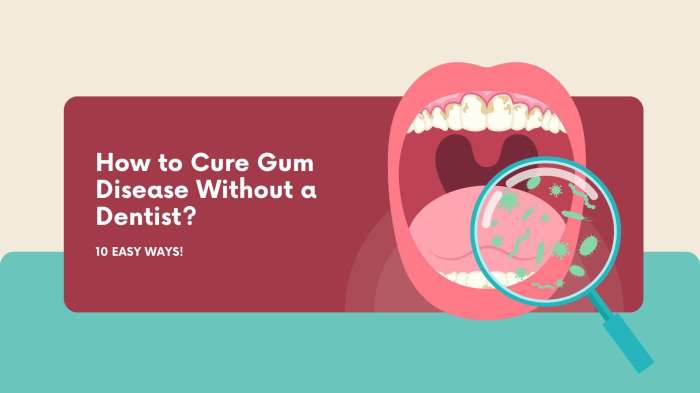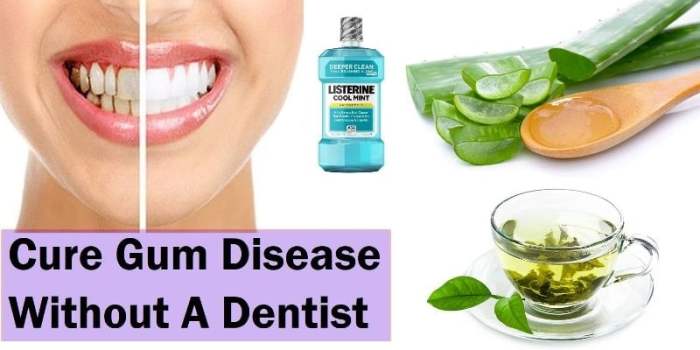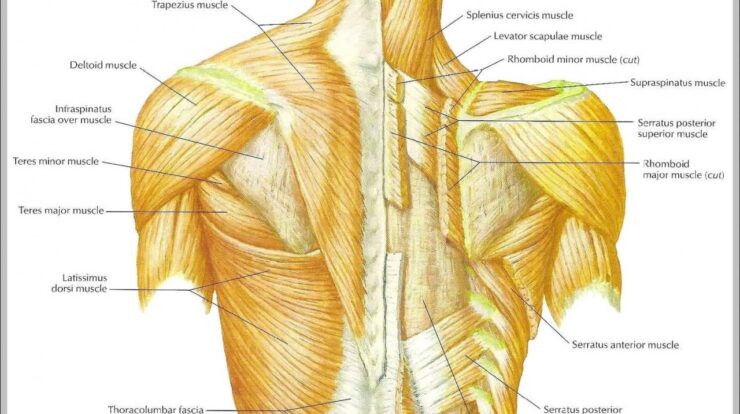
Ready to bid farewell to throbbing gums and embrace a healthy smile? Join us as we delve into the secrets of how to cure gum disease without a dentist. From natural remedies to over-the-counter solutions, we’ve got you covered. So, grab a cuppa, sit back, and let’s get those gums back in tip-top shape!
Before we dive in, remember that while these methods can provide relief, they are not a substitute for professional dental care. Regular checkups and cleanings are still essential for maintaining optimal oral health.
Home Remedies: How To Cure Gum Disease Without A Dentist
Gum disease is a common problem that can be caused by a variety of factors, including poor oral hygiene, smoking, and certain medical conditions. While there are a number of different ways to treat gum disease, many people prefer to try home remedies first.
These remedies are often natural and inexpensive, and they can be just as effective as traditional treatments.
One of the most popular home remedies for gum disease is salt water rinses. Salt water is a natural antiseptic and antibacterial agent, and it can help to reduce inflammation and bleeding. To make a salt water rinse, simply dissolve 1/2 teaspoon of salt in 8 ounces of warm water.
Rinse your mouth with the salt water for 30 seconds, then spit it out. Repeat this process several times a day.
Another effective home remedy for gum disease is tea tree oil. Tea tree oil is a natural antibacterial and antifungal agent, and it can help to kill the bacteria that cause gum disease. To use tea tree oil, add a few drops to a glass of water and swish it around your mouth for 30 seconds.
Spit out the water and rinse your mouth with plain water.
Baking soda is another common home remedy for gum disease. Baking soda is a natural alkaline agent, and it can help to neutralize the acids that cause gum disease. To use baking soda, make a paste by mixing 1/2 teaspoon of baking soda with a little water.
Apply the paste to your gums and leave it on for 5 minutes. Rinse your mouth with plain water.
These are just a few of the many home remedies that can be used to treat gum disease. While these remedies can be effective, it is important to note that they are not a substitute for professional dental care. If you have gum disease, it is important to see a dentist to get a proper diagnosis and treatment plan.
Over-the-Counter Treatments

Over-the-counter (OTC) treatments can help manage gum disease symptoms and improve oral hygiene. These products contain active ingredients that target specific aspects of gum disease, such as inflammation, bacteria, and plaque buildup.
When choosing an OTC treatment, consider your symptoms and the ingredients in the product. For mild gum disease, mouthwashes and gels containing chlorhexidine or triclosan can help reduce inflammation and kill bacteria. For more advanced gum disease, prescription-strength mouthwashes or gels may be necessary.
Mouthwashes
- Chlorhexidine: A strong antiseptic that kills bacteria and reduces inflammation.
- Triclosan: An antibacterial agent that inhibits bacterial growth.
- Cetylpyridinium chloride (CPC): An antiseptic that helps control plaque and gingivitis.
Gels, How to cure gum disease without a dentist
- Chlorhexidine gel: Applied directly to the affected areas, it provides localized treatment for gum disease.
- Triclosan gel: Similar to chlorhexidine gel, it targets specific areas of gum inflammation.
Floss
- Dental floss: Removes plaque and bacteria from between teeth, where brushing alone cannot reach.
- Floss picks: Pre-threaded flossers that make flossing easier for those with dexterity issues.
- Water flossers: Use a stream of water to dislodge plaque and bacteria.
Lifestyle Changes

Gum disease is a serious condition that can lead to tooth loss and other health problems. While there are a number of different ways to treat gum disease, one of the most important things you can do is to make some lifestyle changes.There
are a number of lifestyle changes that can help prevent and treat gum disease. These include:
-
-*Good oral hygiene
Brushing and flossing your teeth twice a day is essential for preventing gum disease. Be sure to brush for at least two minutes each time, and floss at least once a day.
-*A healthy diet
Eating a healthy diet is important for overall health, including oral health. Be sure to eat plenty of fruits, vegetables, and whole grains. These foods are all good sources of vitamins and minerals that are essential for healthy gums.
-*Regular dental checkups
Seeing your dentist for regular checkups is important for preventing and treating gum disease. Your dentist can check your teeth and gums for signs of gum disease, and can provide you with treatment options if necessary.
In addition to these general lifestyle changes, there are a number of other things you can do to improve your oral hygiene and make healthy lifestyle choices. These include:
-
-*Quit smoking
Smoking is one of the worst things you can do for your oral health. Smoking damages the gums and makes them more susceptible to infection.
-*Reduce stress
Stress can contribute to gum disease. Find healthy ways to manage stress, such as exercise, yoga, or meditation.
-*Get enough sleep
Getting enough sleep is important for overall health, including oral health. When you don’t get enough sleep, your body’s immune system is weakened, which can make you more susceptible to infection.
Making these lifestyle changes can help you prevent and treat gum disease, and improve your overall health.
Good Oral Hygiene
Good oral hygiene is essential for preventing and treating gum disease. Brushing and flossing your teeth twice a day is the most important thing you can do to keep your gums healthy.When you brush your teeth, be sure to use a soft-bristled toothbrush and a toothpaste that contains fluoride.
Fluoride helps to strengthen teeth and prevent cavities. Be sure to brush all surfaces of your teeth, including the front, back, and sides.Flossing is also an important part of good oral hygiene. Flossing helps to remove plaque and bacteria from between your teeth, where your toothbrush can’t reach.
Be sure to floss at least once a day, and be sure to floss all the way down to the gum line.In addition to brushing and flossing, there are a number of other things you can do to improve your oral hygiene.
These include:
-
-*Use a mouthwash
Mouthwash can help to kill bacteria and freshen breath. Be sure to choose a mouthwash that contains fluoride.
-*Eat a healthy diet
Eating a healthy diet is important for overall health, including oral health. Be sure to eat plenty of fruits, vegetables, and whole grains. These foods are all good sources of vitamins and minerals that are essential for healthy gums.
-*Avoid sugary drinks
Sugary drinks can damage your teeth and gums. Be sure to limit your intake of sugary drinks, and drink plenty of water instead.
By following these tips, you can improve your oral hygiene and reduce your risk of developing gum disease.
A Healthy Diet
Eating a healthy diet is important for overall health, including oral health. Be sure to eat plenty of fruits, vegetables, and whole grains. These foods are all good sources of vitamins and minerals that are essential for healthy gums.Some specific foods that are good for your gums include:
-
-*Fruits
Fruits are a good source of vitamin C, which is essential for healthy gums. Vitamin C helps to strengthen the connective tissue in your gums and keep them healthy.
-*Vegetables
Vegetables are a good source of fiber, which helps to clean your teeth and gums. Fiber also helps to stimulate saliva production, which helps to neutralize acids in your mouth and protect your teeth and gums.
-*Whole grains
Whole grains are a good source of B vitamins, which are essential for overall health, including oral health. B vitamins help to keep your gums healthy and strong.
In addition to eating a healthy diet, there are a number of other things you can do to improve your oral health. These include:
-
-*Drink plenty of water
Drinking plenty of water helps to keep your mouth moist and free of bacteria.
-*Avoid sugary drinks
Sugary drinks can damage your teeth and gums. Be sure to limit your intake of sugary drinks, and drink plenty of water instead.
-*See your dentist regularly
Seeing your dentist for regular checkups is important for preventing and treating gum disease. Your dentist can check your teeth and gums for signs of gum disease, and can provide you with treatment options if necessary.
By following these tips, you can improve your oral health and reduce your risk of developing gum disease.
Regular Dental Checkups
Seeing your dentist for regular checkups is important for preventing and treating gum disease. Your dentist can check your teeth and gums for signs of gum disease, and can provide you with treatment options if necessary.Regular dental checkups are also important for catching other oral health problems early, such as cavities and oral cancer.
By catching these problems early, your dentist can provide you with treatment options that can help to prevent them from becoming more serious.Be sure to see your dentist for a checkup at least twice a year, or more often if you have any symptoms of gum disease.
Advanced Treatments

In severe cases of gum disease, advanced treatments may be necessary to restore oral health and prevent further damage to the teeth and gums. These treatments include scaling and root planing, laser therapy, and surgery.
Scaling and Root Planing
Scaling and root planing is a non-surgical procedure that involves removing plaque and tartar from the teeth and gums. The procedure is performed using specialized instruments to gently scrape away the buildup from the tooth surfaces and below the gum line.
Scaling and root planing can help reduce inflammation, improve gum health, and prevent further damage to the teeth.
Benefits:
- Non-surgical and less invasive
- Can improve gum health and prevent further damage
Risks:
- May cause temporary sensitivity or discomfort
Recovery Time:
Recovery time is typically short, with most patients experiencing minimal discomfort within a few days.
Laser Therapy
Laser therapy is a minimally invasive procedure that uses a laser to remove diseased tissue and bacteria from the gums. The laser energy targets the affected areas without damaging healthy tissue. Laser therapy can help reduce inflammation, promote healing, and improve gum health.
Benefits:
- Minimally invasive and less painful
- Can promote healing and improve gum health
Risks:
- May require multiple treatments
- Can be more expensive than other treatments
Recovery Time:
Recovery time is typically shorter than with surgery, with most patients experiencing minimal discomfort within a few days.
Surgery
Surgery is an option for severe cases of gum disease that cannot be treated with non-surgical methods. Surgical procedures may involve removing diseased tissue, reshaping the bone, or grafting new tissue to the gums. Surgery can help restore gum health, prevent further damage to the teeth, and improve the overall appearance of the smile.
Benefits:
- Can treat severe cases of gum disease
- Can restore gum health and improve the appearance of the smile
Risks:
- More invasive and painful than other treatments
- May require a longer recovery time
- Can be more expensive than other treatments
Recovery Time:
Recovery time varies depending on the type of surgery performed. Patients may experience discomfort and swelling for several weeks.
Prevention
Preventing gum disease is crucial for maintaining oral health and overall well-being. By practicing good oral hygiene, reducing risk factors, and seeking regular dental checkups, you can significantly lower your chances of developing gum disease.
Here are some essential tips for preventing gum disease:
Maintaining Good Oral Hygiene
- Brush your teeth twice a day with a soft-bristled toothbrush and fluoride toothpaste.
- Floss daily to remove plaque and food particles between teeth.
- Use an antibacterial mouthwash to kill bacteria and freshen breath.
Reducing Risk Factors
- Quit smoking or using tobacco products.
- Manage diabetes and other chronic health conditions.
- Eat a healthy diet rich in fruits, vegetables, and whole grains.
Spotting Early Signs of Gum Disease
- Swollen, red, or bleeding gums.
- Receding gums.
- Loose or sensitive teeth.
Regular Dental Checkups and Professional Cleanings
Regular dental checkups and professional cleanings are essential for preventing gum disease. During these appointments, your dentist will:
- Examine your teeth and gums for signs of gum disease.
- Remove plaque and tartar from your teeth.
- Provide you with personalized advice on how to prevent gum disease.
By following these preventive measures, you can significantly reduce your risk of developing gum disease and maintain a healthy smile for life.
Last Point
And there you have it, folks! By following these tips and tricks, you can effectively manage gum disease at home. Remember, prevention is key, so keep up with your oral hygiene routine and schedule regular dental appointments. Your gums will thank you for it.
Happy smiling!
General Inquiries
Can I cure gum disease completely at home?
While home remedies and over-the-counter treatments can provide relief, professional dental care is necessary to completely cure gum disease.
How long does it take to cure gum disease at home?
The duration depends on the severity of the disease and the effectiveness of the remedies used. However, noticeable improvements can be seen within a few weeks.
Is it possible to prevent gum disease?
Yes, maintaining good oral hygiene, avoiding sugary foods, and quitting smoking can significantly reduce the risk of gum disease.





